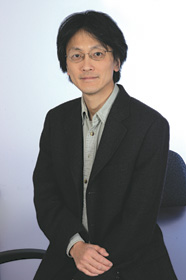Sha Xin Wei brings his topological media to Concordia

Sha Xin Wei
Photo by Bruce Bourcier
Fusion is the first word that comes to mind when referring to Sha Xin Wei. Not only does his research look at the interplay of art and science, but he recently became Concordia’s first Canada Research Chair (CRC) to be jointly appointed by two different faculties.
“I came to Concordia in January, so it’s been incredibly active,” said Sha in an interview from his new office in the J.W. McConnell Building. “It’s a new position and I am an associate professor in Computer Science and in the Department of Design & Computation Arts over at Fine Arts.”
Being named a Tier 2 CRC involves teaching as well as a very elaborate research component. Sha’s work spans many different areas, opening up new possibilities.
“I am trying to invent and set up a place here where students from the sciences, the arts and the humanities can all work together on a meaningful project,” he said. “This could be in a lab, it could be a collective or even a stage production. I am aiming for a project where all these disciplines can work together.”
After earning degrees in mathematics from Harvard and Stanford universities and co-founding various art research groups such as Sponge in San Francisco, Sha settled in 2001 at Georgia Institute of Technology, where he began the Topological Media Lab, a blueprint of the project he hopes to establish at Concordia.
“Topological refers to the way in which we make things.”
Sha is currently teaching a seminar called Introduction to Topological Media.
“The lab at Georgia Tech was part of the computer science department, but the work that was being done there was not strictly engineering. It was also inspired by questions of performance and it incorporated new media.”
One example of the work done in the lab includes public installations where sensors track the motions of people creating music as they move.
These elaborate experiments involve responsive media spaces and require different skills, including costume design, computer graphics, sounds and much more. The results can be shown at media art festivals and cultural venues but can also be used for research in literature, cultural studies, and engineering.
“Three different areas are involved in such projects,” Sha explained. “There are performance, which could be something like media choreography, engineering, which is the technical side, and philosophy, which to me as a researcher is important because it tries to answer fundamental questions like what makes an experience tangible and memorable. All three work in layers and they are all necessary and active.”
Since his arrival at Concordia, Sha has been hard at work fulfilling some of the requirements expected of a Canada Research Chair.
“Besides the teaching, I am doing a lot of grant writing to support programs and future PhD students.” He is also collaborating with artists and researchers from other countries.
“I hope this is a permanent position because it’s exciting to be in a country where there is a lot of support for cultural work from the government and various agencies.”
Sha Xin Wei will give a public lecture tomorrow, March 4, at 3:30 p.m., in the DeSève Cinema as part of the Defiant Imagination series. For more on his projects, visit http://topologicalmedialab.net.